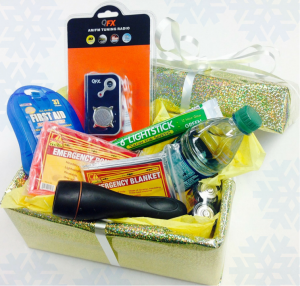December 21, 2015
The holiday season sees worry and wonder about getting the perfect gift for someone: a present that shows you care.
Giving someone the gift of preparedness shows that you care about their safety and well being, especially during a time of emergency.
This can be done with thoughtful gifts. Small items such as flashlights, battery operated AM/FM radios, extra electronics chargers and cords, first aid kits, auto repair tools, blankets, hats and gloves all fit nicely in a stocking, a backpack or a bin.
These items make up the contents of Go Bags, home emergency kits and vehicle emergency travel kits. All a very important and easy first step to being prepared.
Make a Go Bag
A “Go Bag” is a personal evacuation kit. It has basic supplies to help keep you and your family healthy, safe, and financially protected when you need to leave your home quickly.
Be ready to take these things with you:
- Copies of your important documents. These include insurance cards, photo IDs, birth certificates, deeds, proof of address, and your family emergency plan. Keep these in a waterproof bag or box that is also easy to carry.
- Extra set of car and house keys.
- Cash, especially in small bills (ones, fives, and tens). You may not be able to use credit cards or ATM cards if the power is out.
- Bottled water and ready-to-eat foods such as energy or granola bars.
- Flashlight and extra batteries.
- Battery-operated AM/FM radio and extra batteries. You can also buy wind-up radios that do not require batteries.
- Medications and health information, including:
- A three-day supply of all medicines. Make a habit of refilling medications before they run out or expire.
- A health information card for each person in your household, or a list of the medicines each member of your household takes. Include the name of the medicine, the dosage, what it’s for, and when to take it, such as after eating or before bedtime.
- Copies of all prescriptions, and contact information for your family’s doctors and pharmacists.
- First aid kit.
- Comfortable and sturdy shoes, a lightweight rain coat, and a mylar blanket.
- Contact and meeting place information for your household.
- A local map showing your neighborhood’s emergency evacuation routes (PDF).
- Personal care items: hand sanitizer, feminine products, toothbrush and toothpaste, toilet paper and wipes.
- Special care items, including child care supplies, items for special needs, and pet supplies.
Make a Home Emergency Kit
A Emergency may require you to stay inside your residence for extended periods of time. This is known as “Shelter-in-place”. It’s a way to keep safe during some kinds of emergencies, such as winter storms, hurricanes, and tornadoes. You may also be told to shelter-in-place during police activity or the release of a gas or chemical, where going outside could put you in harm’s way. If you’re told to stay where you are during an emergency, being prepared will help you and your family.
What to Put in Your Home Emergency and Shelter-In-Place Kit
Your shelter-in-place kit needs to have enough supplies to last up to three (3) days.
Make sure to include the following items in your kit. You can get many of these at a dollar store.
- One gallon of drinking water for each person for each day. Include food and water for pets
- Ready-to-eat or canned foods that won’t spoil quickly
- Manual can opener
- Forks, spoons, knives, plates, and cups
- First aid kit
- Flashlight and extra batteries
- Battery-operated AM/FM radio and extra batteries. You can also buy wind-up radios that don’t need batteries
- Fully-charged backup batteries or power banks for cell phones
- A whistle to signal for help
- Iodine tablets or one quart of unscented bleach and an eyedropper. To disinfect water with bleach, add 8 drops of bleach for each gallon of water. Disinfect water only if told to do so by health officials.
- Personal hygiene items for each person, such as hand sanitizer, soap, toothbrush and toothpaste, feminine hygiene products, toilet paper, and wipes
- Child care supplies or other special care items
- Trash bags, plastic sheeting, scissors, and duct tape
- Common tools
- A copy of your family emergency plan
Prepare your vehicle with an Emergency Travel Kit
Always keep an emergency travel kit in your vehicle in case it breaks down or if you need to pull over due to dangerous conditions.
- Flashlight and extra batteries
- Battery-operated or wind-up radio
- Jumper cables
- Emergency flares
- Fluorescent distress flag
- Tow chains or rope
- Mobile phone and charger
- First aid supplies
- Warm clothing, hats and mittens
We at Philadelphia Office of Emergency Management would like to give you something too. During an emergency, it is vital to have communication and stay up-to-date with information from the City. We provide this in the form of text, email, and voice alerts from our ReadyPhiladelphia system. It’s free and takes only a minute to sign up.
Also, follow us on Twitter and Like us on Facebook for important updates.

